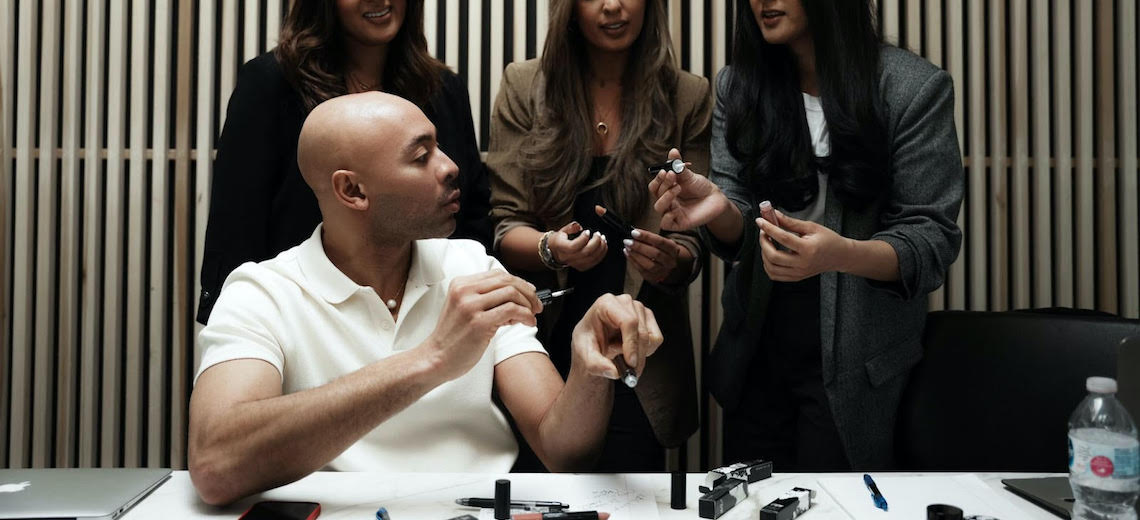Known for his work on A-list clients like Beyonce, Karlie Kloss, Naomi Campbell and Kim Kardashian, makeup artist Sir John joined Ctzn Cosmetics as its new chief creative officer and board member in April. Sir John, who is also a creative director for L’Oréal Paris USA, is bringing his more than two decades of celebrity experience to the indie brand.
Also taking a seat on the board and equity in the brand, he will help lead product launches and strategies for growth.
Launched just over three years ago by co-founders and sisters Aleena, Aleezeh and Naseeha Khan, the brand is focused on products for underrepresented demographic groups and has garnered buzz for its diverse range of nude lipsticks. The lipstick especially saw a surge in October 2021, when beauty influencer Mikayla Nogueira reviewed the brand’s lipstick and influencer Erin Dugan stitched the review. The influx of traffic crashed the website for a period of time, and sales rose by more than 12,000% after her review was posted. According to Sir John, one of the goals for the brand will be to expand the cult appeal of the brand’s lipstick to other product categories including eyes and contour.
We caught up with Sir John to talk about his creative vision for Ctzn, his beauty inspirations and creative process, and his dedication to being “anti-trend,” when it comes to his approach to makeup.
How did you link up with the brand and how did the new role come about?
“I knew about the products for a while and about the universal range. I was introduced to one of the investors and I fell in love with the mission behind Ctzn, which is to lean into an inclusive landscape for the beauty community — making sure that everyone feels seen and heard, and that people felt like they’re on our radar when we’re manufacturing and designing products, from design to colors.… Beauty is a feeling, It’s not something you can always see.”
How does your background as a makeup artist inform product development?
Ad position: web_incontent_pos1
“We’re on the front lines. We see so much. I get tons of boxes of everything daily.… I’ve been able and blessed to work in different genres, [including] red carpet, stadiums, Super Bowls and Coachellas, as well as cover stories in the editorial market. They are all completely different. That’s how the business has trained me to look at products: ‘Is it good?’ ‘Is not going to waste someone’s time?’ ‘Is it going to be too hard to use?’ Those are all the kinds of things clicking through my mind when I see a product.”
How much are you able to share about your creative vision for the brand going forward?
“Packaging is key. As we become more mature, we care more about the way something is constructed, the look and feel. And looking at Gen Z, they love to photograph things.”
How does this role compare to collabs you’ve done in the past?
“I love the stuff that I’ve done with Barbie. “The Lion King” collection was able to touch so many people and also gave me a connection to the South African market and the diaspora of Africa, in general. All of these things have really been beautiful feathers in my cap. What that allows me to do now is have informed decisions and know what we’re going into. The guesswork is gone.”
Ad position: web_incontent_pos2
What have you seen at this point in the pandemic with makeup; has makeup made its big comeback?
“What the pandemic allowed us to do is look at our skin in a different way. We’re OK wearing less foundation. We’re OK with less coverage. But then there’s also this dichotomy where people want to have fun with it. Makeup is making a big comeback, it’s coming back, but [now it’s] a little bit more [about] looking inward: ‘How does this make me feel?'”
What trends from social media do you have your eye on?
“I don’t really believe in trends. I’m anti-trend and anti-celebrity, in a sense. Twenty years ago, even 10 years ago, it was always about what celebrities were wearing. What’s cool about now is that you can go right to the people: How do people want to look? Celebrities are not really influencing us the way they used to, but the people are influencing each other.”
Over the course of your career, how much has social media changed beauty?
“I’ll say it’s a gift and a curse, because the beautiful thing about social media — the democracy of it — is that people have voices. People want to feel seen and championed. Body positivity is because of social media. This inclusive landscape of beauty is because of social. If we were waiting on the fashion industry or the beauty industry, we would still be waiting for us to feel invited, or seen, or represented.
The not-so-bright side of our business is that social media can be harmful. It can induce anxiety and depression on a younger generation of people, on all of us. It’s important for us to make sure that we’re taking a second to check in, to do a temperature check. There should be some kind of reckoning to make sure we’re not making people feel like they shouldn’t look like themselves.”
Apart from Instagram, are you looking at other platforms?
“I’m jumping on TikTok next week. I like that it’s loose and haphazard and not perfect.”
This interview was lightly edited and condensed for clarity.


